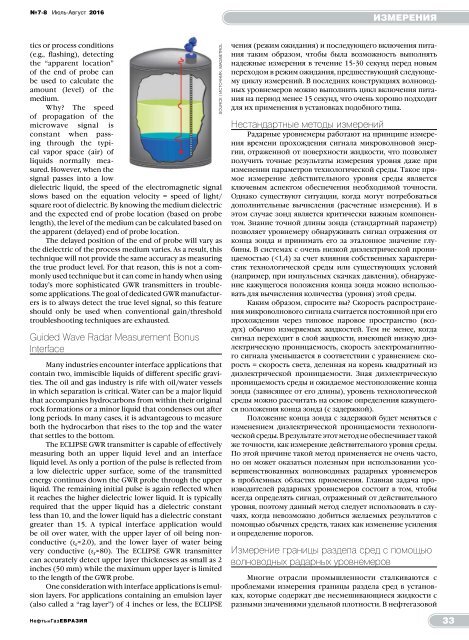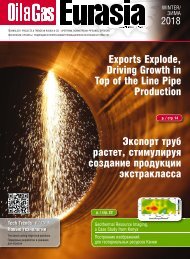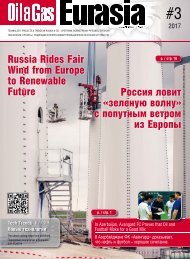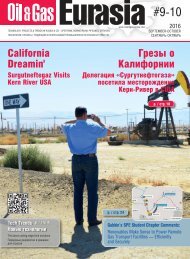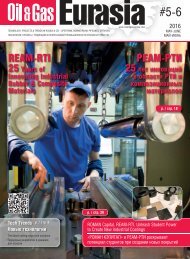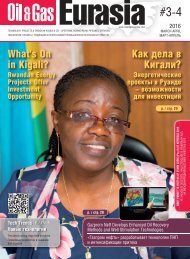Oil&Gas Eurasia July-August 2016
July-August issue of Oil&Gas Eurasia magazine
July-August issue of Oil&Gas Eurasia magazine
You also want an ePaper? Increase the reach of your titles
YUMPU automatically turns print PDFs into web optimized ePapers that Google loves.
№7-8 Июль-Август <strong>2016</strong><br />
ИЗМЕРЕНИЯ<br />
tics or process conditions<br />
(e.g., flashing), detecting<br />
the “apparent location”<br />
of the end of probe can<br />
be used to calculate the<br />
amount (level) of the<br />
medium.<br />
Why? The speed<br />
of propagation of the<br />
microwave signal is<br />
constant when passing<br />
through the typical<br />
vapor space (air) of<br />
liquids normally measured.<br />
However, when the<br />
signal passes into a low<br />
dielectric liquid, the speed of the electromagnetic signal<br />
slows based on the equation velocity = speed of light/<br />
square root of dielectric. By knowing the medium dielectric<br />
and the expected end of probe location (based on probe<br />
length), the level of the medium can be calculated based on<br />
the apparent (delayed) end of probe location.<br />
The delayed position of the end of probe will vary as<br />
the dielectric of the process medium varies. As a result, this<br />
technique will not provide the same accuracy as measuring<br />
the true product level. For that reason, this is not a commonly<br />
used technique but it can come in handy when using<br />
today’s more sophisticated GWR transmitters in troublesome<br />
applications. The goal of dedicated GWR manufacturers<br />
is to always detect the true level signal, so this feature<br />
should only be used when conventional gain/threshold<br />
troubleshooting techniques are exhausted.<br />
Guided Wave Radar Measurement Bonus<br />
Interface<br />
Many industries encounter interface applications that<br />
contain two, immiscible liquids of different specific gravities.<br />
The oil and gas industry is rife with oil/water vessels<br />
in which separation is critical. Water can be a major liquid<br />
that accompanies hydrocarbons from within their original<br />
rock formations or a minor liquid that condenses out after<br />
long periods. In many cases, it is advantageous to measure<br />
both the hydrocarbon that rises to the top and the water<br />
that settles to the bottom.<br />
The ECLIPSE GWR transmitter is capable of effectively<br />
measuring both an upper liquid level and an interface<br />
liquid level. As only a portion of the pulse is reflected from<br />
a low dielectric upper surface, some of the transmitted<br />
energy continues down the GWR probe through the upper<br />
liquid. The remaining initial pulse is again reflected when<br />
it reaches the higher dielectric lower liquid. It is typically<br />
required that the upper liquid has a dielectric constant<br />
less than 10, and the lower liquid has a dielectric constant<br />
greater than 15. A typical interface application would<br />
be oil over water, with the upper layer of oil being nonconductive<br />
(ε r ≈2.0), and the lower layer of water being<br />
very conductive (ε r ≈80). The ECLIPSE GWR transmitter<br />
can accurately detect upper layer thicknesses as small as 2<br />
inches (50 mm) while the maximum upper layer is limited<br />
to the length of the GWR probe.<br />
One consideration with interface applications is emulsion<br />
layers. For applications containing an emulsion layer<br />
(also called a “rag layer”) of 4 inches or less, the ECLIPSE<br />
SOURCE / ИСТОЧНИК: MAGNETROL<br />
чения (режим ожидания) и последующего включения питания<br />
таким образом, чтобы была возможность выполнять<br />
надежные измерения в течение 15-30 секунд перед новым<br />
переходом в режим ожидания, предшествующий следующему<br />
циклу измерений. В последних конструкциях волноводных<br />
уровнемеров можно выполнить цикл включения питания<br />
на период менее 15 секунд, что очень хорошо подходит<br />
для их применения в установках подобного типа.<br />
Нестандартные методы измерений<br />
Радарные уровнемеры работают на принципе измерения<br />
времени прохождения сигнала микроволновой энергии,<br />
отраженной от поверхности жидкости, что позволяет<br />
получить точные результаты измерения уровня даже при<br />
изменении параметров технологической среды. Такое прямое<br />
измерение действительного уровня среды является<br />
ключевым аспектом обеспечения необходимой точности.<br />
Однако существуют ситуации, когда могут потребоваться<br />
дополнительные вычисления (расчетные измерения). И в<br />
этом случае зонд является критически важным компонентом.<br />
Знание точной длины зонда (стандартный параметр)<br />
позволяет уровнемеру обнаруживать сигнал отражения от<br />
конца зонда и принимать его за эталонное значение глубины.<br />
В системах с очень низкой диэлектрической проницаемостью<br />
(


